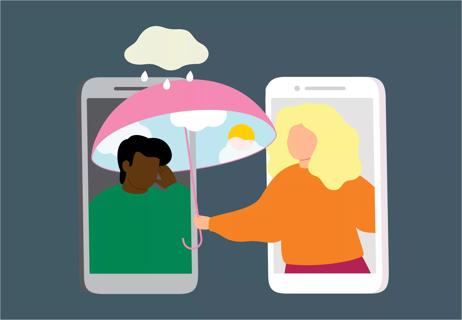You can’t fix your friend’s problems, but there are other things you can do

You’ve noticed some changes in your friend that concern you. You’re not sure if it’s depression or just a bad few days, but you want to help. So where do you start?
Advertisement
Cleveland Clinic is a non-profit academic medical center. Advertising on our site helps support our mission. We do not endorse non-Cleveland Clinic products or services. Policy
Clinical psychologist Adam Borland, PsyD, gives some strategies that can help you provide support.
Depression touches most Americans, whether they experience it personally or it affects someone they know. In fact, The National Institute of Mental Health reports it’s one of the most common mental health disorders in the United States — an estimated 17.3 million adults were living with depression in 2017.
So how can you tell if a friend is just a bit sad or has something deeper brewing? “There certainly are telltale signs,” Dr. Borland notes. “But since you don’t necessarily see that person every day, you may have to do more detective work.”
He recommends watching for behavioral changes or anything that could be out of character for your friend. Some depression symptoms include:
Advertisement
Dr. Borland recommends some do’s and don’ts to get the conversation going:
Rather than making depression taboo, talk openly with your friend about your concerns. Dr. Borland recommends cultivating the art of assertive communication: You take ownership of your feelings and concerns and communicate them without finger-pointing. And you listen and provide your friend with unconditional emotional support.
To do this, practice using “I” statements. “Begin sentences with, ‘I’m worried,’ ‘I’m concerned’ or ‘I’ve noticed.’ Then explain your concerns to your friend,” he suggests. “Avoid saying, ‘You don’t seem like yourself,’ or ‘You haven’t been hanging out as much as you usually do.’ They can create defensiveness in the person receiving the message.”
Put yourself in your friend’s shoes in a nonjudgmental way. Think about how you would feel if you were coping with symptoms of depression and how you would want friends to react. Maintain eye contact when listening, and say things like, “That sounds hard. I’m sorry you are going through this,” and “I’m always here for you.”
“And if you’ve dealt with depression yourself, self-disclosure can be very powerful,” Dr. Borland points out. “You’re giving your friend a gift by opening yourself up and sharing that you understand.’”
By responding to your friend in an open and empathetic way, you show them that they aren’t a burden.
It’s OK to be specific about when you can — or can’t — be there for your friend. For example, let your friend know that it’s better for you to talk after your kids are in bed. And don’t accept abusive or violent behavior. If they don’t stop, do what’s best for your health and safety.
Self-care is also key. Monitor your own health and well-being so you have something to give when the going gets tough. Supporting someone with depression can take a lot out of you. Learn your limits and when it’s time to recharge your batteries. Explain to your friend that while you’re there for them, a mental health professional has the training and tools needed to effectively treat them.
There is no quick fix for depression. The recovery process takes time. You’re less likely to get frustrated with, or give up on, your friend if you’re hunkered down for the long haul.
Recognize that supporting your friend does not mean fixing their problems. A person with depression often needs treatment to see improvement — and that’s something only a medical professional can provide.
But what if your friend rejects your efforts even when you’ve done all the right things?
“Their rejection may be a defense mechanism. They realize you’re recognizing their symptoms and that they’re not doing as good a job hiding them as they thought,” explains Dr. Borland. “It’s easy to react negatively to a friend who’s unwilling to get help. But stick with them and maintain communication. Continue to check in on your friend and encourage them to get help.”
Advertisement
Dr. Borland also recommends trying to be there with your friend instead of for your friend. “It means I’m in this with you, even if you push me away,” he says.
If you are concerned your friend may harm themselves, don’t dismiss your gut. Instead:
That help may include outpatient therapy and psychotropic medications prescribed by their primary care doctor or a psychiatrist. If you think your friend is in immediate danger, call 911 or take your friend to the nearest emergency department.
Remember: Your friend’s situation is not hopeless. Like other illnesses, depression can be treated with the right medical help and the support of friends like you.
Advertisement
Learn more about our editorial process.
Advertisement

People with high-functioning depression may not seem depressed on the outside, but the condition can cause turmoil on the inside

The holidays can be hard on your mental health, but there are ways to cope

More than just ‘deep sadness,’ this complex condition is often a whole-body experience

Learning your warning signs can help push back against an episode of depression

Noninvasive TMS may work when antidepressants don’t

From global pandemics to other life stressors

Plus how you can get back on track

Depression is tough on a relationship — here’s how to get through it

If you’re feeling short of breath, sleep can be tough — propping yourself up or sleeping on your side may help

If you fear the unknown or find yourself needing reassurance often, you may identify with this attachment style

If you’re looking to boost your gut health, it’s better to get fiber from whole foods